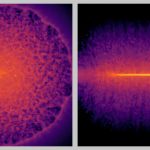After nearly 100 years, dark matter may finally have been seen
Nearly 100 years ago, astronomer Fritz Zwicky made a strange discovery while studying the movement of galaxies.
He noticed that galaxies were moving far faster...
Hidden power in particle accelerators could help fight cancer
Inside the world’s most powerful particle accelerators, enormous amounts of energy are used to explore the deepest secrets of the universe.
But new research suggests...
Scientists recreate 100 billion stars in a virtual Milky Way for the first time
Scientists have achieved something that once seemed nearly impossible: they have created the first computer simulation of the Milky Way that represents more than...
Scientists discover light’s hidden magnetic power after 180 years
For nearly two centuries, scientists have believed that only the electric side of light played a role in certain magnetic effects.
Now, a new study...
Yes, the universe can expand faster than light
An expanding universe complicates this picture just a little bit, because the universe absolutely refuses to be straightforward.
Objects are still emitting light, and that...
Scientists put the speed of light to the ultimate test — and it still...
More than a century ago, two American scientists, Albert Michelson and Edward Morley, carried out a famous experiment that changed the course of physics.
They...
Scientists repeat a famous light experiment using sound—and discover new physics
More than 200 years ago, physicist Thomas Young amazed the scientific world when he showed that light behaves like both a wave and a...
How dark energy changed cosmology forever
Let’s rewind the clock back…oh, I don’t know, let’s say a hundred years. It was 1917, and Einstein had just developed his general theory...
Could mass come from the shape of space instead of the Higgs Boson?
In modern physics, the Higgs boson is famous for giving particles their mass.
But a new study suggests an entirely different possibility: mass might come...
Princeton builds a qubit that lasts 1,000 times longer than today’s chips
In a groundbreaking leap toward practical quantum computers, engineers at Princeton University have created a superconducting qubit that lasts over one millisecond—three times longer...










